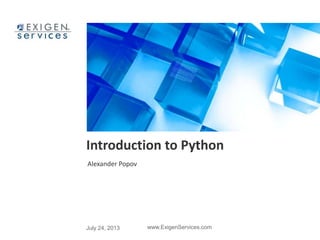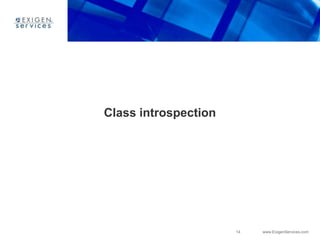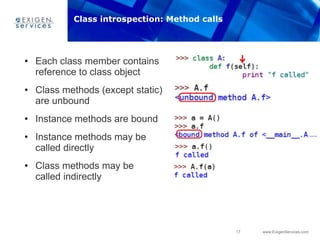Introduction to python
- 1. Introduction to Python Alexander Popov July 24, 2013 www.ExigenServices.com
- 2. 2 www.ExigenServices.com • Who‟s using it? • Why? • Overview • Kind of magic: special keywords • Decorators • Samples • Zen Presentation index
- 3. 3 www.ExigenServices.com Who’s using it? Sourceforge, Fedora community TurboGears Google, Yahoo, Zope, Battlefield 2, Vampires: TM, Civilization 4, Blender, SGI, Red Hat, Nokia, Caligari, ABN AMRO Bank, NASA, Thawte consulting, IBM, …… OVER 9000! Python Instagram, Pinterest, Mozilla, The Guardian, The New York Times, The Washington Post, Quora Django
- 5. 5 www.ExigenServices.com Why Python, not Ruby, Smalltack, Brainf*ck? • Small core • 29 keywords, 80 built-in functions • Elegant syntax • Embeddable to everything you want • True cross platform • Absolutely free • Extendable (via C++ modules) • Rich standard library • Binding almost to everything
- 6. 6 www.ExigenServices.com • Fast logic prototyping • It automates for you mechanical work • Improves you mind • Force you to write clear code (on other langs also, sad but true) • Web development • Desktop development • Access to system internal features (WinAPI, Dbus) • You can find tool for everything. Why should I spend my time on it instead of beer?
- 7. 7 www.ExigenServices.com • Easier than Pascal • Better than Basic • Slimmer than PHP • Prettier than Ruby (empty? empty! empty!! empty!!!!!) • Does not suffer of abundance of parentheses (((hello) (,) (Lisp!))) • Pointers? What is it? Ahhhh, it is C++! • More much dynamic than Java (hello, dynamic typing) • Improves karma and makes you happy Wait, what does it means? Really, why?
- 8. 8 www.ExigenServices.com • Structural • OOP • Functional • Imperative • Aspect-oriented Python paradigms
- 10. 10 www.ExigenServices.com • Dynamic (duck) typing • Variety of basic data types • Hierarchy marked by indentation • Code may be grouped to modules • Exception infrastructure • Advanced features like generators and list comprehension • Garbage collector and automatic memory management Overview: Heap, part 1
- 11. 11 www.ExigenServices.com • Function marked by keyword „def‟ • Classes marked by keyword „class‟ • String are immutable • Special keywords surrounded by double underscore • Variables not marked. Just assign and use. • Lambda functions • Object model Overview: Heap, part 2
- 12. 12 www.ExigenServices.com • Do you like objects? • Class instance is object • Class definition is object too. • Functions. It is objects also. • Aren‟t you bored of objects? Elementary types are objects. • Types… Ok, you know… • EVERYTHING IS OBJECT! Everything is object! No exceptions.
- 13. 13 www.ExigenServices.com • Just one operator • Function-powered variant • Class example Hello world
- 15. 15 www.ExigenServices.com • There are matter how to declare class data members: class- or instance-wide. • Class data members Declared inside class body. Accessible for all instances • Instance data members Declared inside constructor. Accessible only for one instance. Class introspection: Members declaration
- 16. 16 www.ExigenServices.com • Data members • Public (no special marks) • Private-by-convention (started with at least one underscore and finished with not more than 1 underscore) • Private-by-mangling (started with 2 underscores and finished with not more than 1 underscore) Class introspection: Member access
- 17. 17 www.ExigenServices.com • Each class member contains reference to class object • Class methods (except static) are unbound • Instance methods are bound • Instance methods may be called directly • Class methods may be called indirectly Class introspection: Method calls
- 18. 18 www.ExigenServices.com • Class definition creation on the fly • Metaclasses Class introspection: Fatality
- 20. 20 www.ExigenServices.com • Immutable • String • Unicode • Tuple • Mutable • List • Byte Array • Pseudo sequences • Sets & frosensets • Dictionary Sequences
- 22. 22 www.ExigenServices.com 0 1 2 3 [1, 2, 3, 4] -4 -3 -2 -1 • Index model: • Indexation • Indices started from 0 • Indices may be negative • Slices • With positive indices • With negative indices (be careful with order!) • With step Sequences indexation and slicing
- 23. 23 www.ExigenServices.com Ranges and generators
- 24. 24 www.ExigenServices.com • Ranges • range( [start], stop, [step] ) • xrange( [start], stop, [step] ) • Generator Ranges and generators
- 26. 26 www.ExigenServices.com • Started and finished with 2 underscore: __foo__ • __call__ • __add__ • __iadd__ • Using special keywords we can emulate any native type: • Callable (__call__) • Container (__len__, __getitem__, __setitem__, __delitem__, __iter__, __reversed__, …) • Numeric (__add__, __sub__, __mul__, __floordiv__, ...) Special keywords magic
- 28. 28 www.ExigenServices.com • Decorator • A function that takes one argument (i.e. the function being decorated) • Returns the same function or a function with a similar signature (i.e. something useful) • Still WTF? Do not bother, “what is decorator” is one of most popular Python questions Decorators
- 29. 29 www.ExigenServices.com • Similar interface • Similar behavior • But not the same Decorators, live
- 30. 30 www.ExigenServices.com • Declare the decorator • Wrap the function • … • PROFIT! • Hey! I want to wrap MY function! • Add some magic • … • PROFIT again! Decorators: Wrap the function
- 31. 31 www.ExigenServices.com A bit harder… Decorators: Count function calls
- 32. 32 www.ExigenServices.com Decorators: Count function calls, usage
- 33. 33 www.ExigenServices.com Meet the Samples
- 34. 34 www.ExigenServices.com • Simple HTTP server python -m SimpleHTTPServer 8888 • SMTP server python -m smtpd -n -c DebuggingServer localhost:25 • CGI server python -m CGIHTTPServer 9080 • How many bytes in… zip( ('Byte','KByte','MByte','GByte',TByte'), (1 << 10*i for i in xrange(5)) ) • Windows clipboard import win32clipboard win32clipboard.OpenClipboard() win32clipboard.EmptyClipboard() win32clipboard.SetClipboardText(text) win32clipboard.CloseClipboard() One-, two- and three-line scripts, part 1
- 35. 35 www.ExigenServices.com • Decode base64 import base64, sys; base64.decode( open(“encoded.file”, "rb"), open(“decoded.file”, "wb") ) • COM • Test via Python • Test via VB One-, two- and three-line scripts, part 2
- 37. 37 www.ExigenServices.com • Import module Flask • Create application • Add route and view • Run application Flask micro framework, part 1
- 38. 38 www.ExigenServices.com Flask micro framework, part 2
- 39. 39 www.ExigenServices.com Flask micro framework, part 3 Alex
- 40. 40 www.ExigenServices.com • Fast • Customizable • Rich functionality Templating with Jinja2
- 41. 41 www.ExigenServices.com Templating with Jinja2
- 42. 42 www.ExigenServices.com • http://docs.python.org/ • http://learnpythonthehardway.org/ • Google Python Days on Youtube • Coursera: https://www.coursera.org/course/interactivepython https://www.coursera.org/course/programming1 • EdX: https://www.edx.org/courses/MITx/6.00x/2012_Fall/about • Google, do you speak it?! • Stackoverflow • http://www.tornadoweb.org/ • http://www.pylonsproject.org/ • https://www.djangoproject.com/ • http://flask.pocoo.org/ • http://wiki.python.org/moin/PythonDecoratorLibrary Additional resources
- 43. 43 www.ExigenServices.com >>> import this • Beautiful is better than ugly. • Explicit is better than implicit. • Simple is better than complex. • Complex is better than complicated. • Flat is better than nested. • Sparse is better than dense. • Readability counts. • Special cases aren't special enough to break the rules. • Although practicality beats purity. • Errors should never pass silently. • Unless explicitly silenced. to be continued… The Zen of Python
- 44. 44 www.ExigenServices.com >>> import this • In the face of ambiguity, refuse the temptation to guess. • There should be one-- and preferably only one --obvious way to do it. • Although that way may not be obvious at first unless you're Dutch. • Now is better than never. • Although never is often better than *right* now. • If the implementation is hard to explain, it's a bad idea. • If the implementation is easy to explain, it may be a good idea. • Namespaces are one honking great idea -- let's do more of those! The Zen of Python, part 2
- 46. 46 www.ExigenServices.com main.py (Create application, initialize database, setup error handlers, Add blueprints) |=> application1 (account, blog, core) |=> constants.py (application-wide constants) |=> forms.py (form used in application) |=> models.py (database models) |=> views.py (views) |=> utils.py |=> application2 |=> constants.py |=> forms.py |=> models.py |=> views.py |=> utils.py ………….. Flask blog code explanation, structure
- 47. 47 www.ExigenServices.com Flask blog code explanation, constants
- 48. 48 www.ExigenServices.com Flask blog code explanation, forms
- 49. 49 www.ExigenServices.com Flask blog code explanation, models
- 50. 50 www.ExigenServices.com Flask blog code explanation, views
- 51. 51 www.ExigenServices.com Flask blog code explanation, templates
- 52. 52 www.ExigenServices.com Thank you! P.S.: You are fantastic!






















![22 www.ExigenServices.com
0 1 2 3
[1, 2, 3, 4]
-4 -3 -2 -1
• Index model:
• Indexation
• Indices started from 0
• Indices may be negative
• Slices
• With positive indices
• With negative indices
(be careful with order!)
• With step
Sequences indexation and slicing](https://image.slidesharecdn.com/introductiontopython-130724063136-phpapp01/85/Introduction-to-python-22-320.jpg)

![24 www.ExigenServices.com
• Ranges
• range( [start], stop, [step] )
• xrange( [start], stop, [step] )
• Generator
Ranges and generators](https://image.slidesharecdn.com/introductiontopython-130724063136-phpapp01/85/Introduction-to-python-24-320.jpg)
























































































































